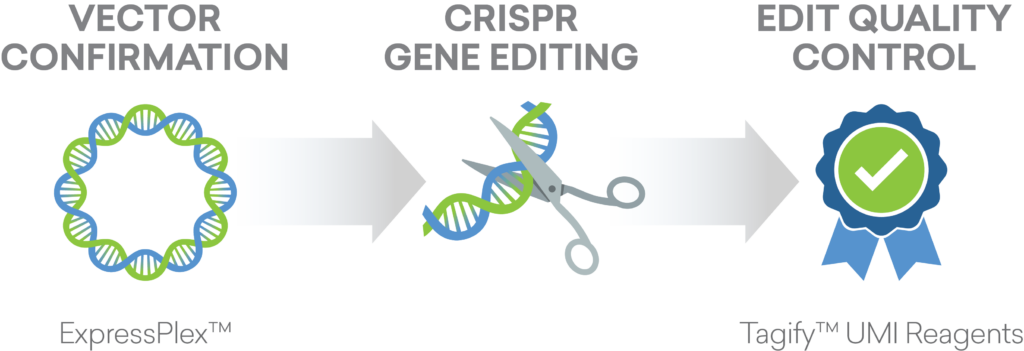
Introduction
Quality control (QC) analysis is an integral component of gene editing methods like CRISPR. Implementing QC checkpoints at critical junctures throughout the process eliminates unsuitable samples, saves time and money, and maximizes resources. In turn, this increases confidence in results and builds consistency in the workflow.1
Next-generation sequencing (NGS) is a particularly powerful tool for gene editing QC. The addition of transposase-based library prep enhances the safety of gene editing resulting in more effective treatment options for a wide range of disorders.2,3
There are four classes of CRISPR-Cas-derived genome editing agents that are currently available for modifying genomes in experimental systems:4
- Nucleases
- Base editors
- Transposases/recombinases
- Prime editors
These genome editing agents have proven to be effective—Some have already made their way into the clinical setting and are showing promise in human gene therapy. Still, each tool has its own set of capabilities and limitations, and scientists are working to improve their efficiency, specificity, and targeting scope.5
Moreover, it’s critical to measure and characterize off-target mutagenesis when using CRISPR/Cas9. However, generating genomic DNA libraries by fragmentation, size selection, end-repair and ligation prior to PCR can be laborious, slow, and prone to bias. Library amplification is often followed by inefficient hybridization-based enrichment of sequences of interest to reduce sequencing cost.6
Upstream Gene Editing QC
Most gene therapy applications use viral vectors to carry the therapeutic gene into target cells.7 Retroviral and adenoviral vectors were among the first cell modifying vectors and now, more recently, adeno-associated virus (AAV) and lentiviral (LV) vectors have progressed primarily due to their enhanced safety and improved target tissues expression profiles.
The manufacture of viral vectors can be a complex process, requiring several manufacturing phases or platforms. The final vector product must be well characterized and of the correct quantity, purity, and potency for both producers and regulatory authorities. This can only be achieved if adequate characterization methods are in place and the viral product process is well established, understood, and reproducible. Control and product characterization are not only important for final product but also within the various steps of the production process.
seqWell has pushed us another step forward in helping scientists produce high-quality constructs with the ExpressPlex™ Library Prep Kit.8 This innovative solution can be used as an upstream QC method to verify the DNA sequence of the reagents used in gene editing labs prior to the gene editing process. This helps scientists ensure the safety of their final vector product.
Downstream Gene Editing QC
The purpose of downstream processing is to separate the viral vector from the impurities produced during upstream processing as well as to get the virus into the correct state for formulation and administration to patients.9
Current downstream processing generally has a similar workflow, which involves a clarification step sometimes proceeded by cell lysis, then purification, and ending with polishing. Additionally, filtration/dialysis/centrifugations steps are typically utilized to concentrate for buffer exchange or final formulation.
Viral vectors that will be used in clinical practice must comply to regulatory standards because impurities and contaminants can affect safety and potency. Additionally, the use of lysis buffers, affinity resins, and other methods can introduce contaminants, which would then need analytical assays and additional processing steps. Aggregation can be an issue especially when viruses are released by lysis or when concentrated. So labs must take precautions to ensure no contaminations are introduced at any point in the downstream process.
To help address and overcome some of these concerns, seqWell has introduced the Tagify™ UMI Tn5 transposase-based reagents.10 These reagents can be leveraged as a downstream tool for sequencing verification of gene editing products, which the team at Editas Medicine has done for their UDiTaS method. Thanks to the incorporation of UMIs, gene editing efficiency and fidelity can be quantified at the on-target molecular level, providing an accurate assessment of the gene editing outcome after the editing process has taken place.11
Using ExpressPlex and Tagify in Tandem
To ensure the accuracy and precision of gene editing products, researchers can take advantage of the combined power of ExpressPlex and Tagify. These two QC activities work together to provide a comprehensive approach to monitoring the gene editing process. Using ExpressPlex upstream and Tagify downstream allows researchers to effectively sandwich their gene editing between two reliable QC points.

By using these tools in tandem, researchers can better control editing reagents and the overall editing process. This can also be helpful if the QC activities are being performed in different labs within the same company, as it allows for a more streamlined workflow and reproducible results.
Conclusion
Ensuring the safety and efficacy of gene editing techniques is crucial to advancing research and medical treatment. The use of transposase-based approaches, such as seqWell’s ExpressPlex and Tagify products, provides researchers with a unique advantage in gene editing QC. By enabling researchers to accurately quantify edited DNA and identify off-target effects quickly and efficiently, transposase-based approaches like these have the potential to significantly advance the field of gene editing.
References
- https://www.future-science.com/doi/pdf/10.2144/btn-2017-3001
- https://seqwell.com/improve-gene-editing-with-tn5-transposase/
- https://pubmed.ncbi.nlm.nih.gov/34619370/
- https://pubmed.ncbi.nlm.nih.gov/32572269/
- https://www.ncbi.nlm.nih.gov/pmc/articles/PMC8992613/
- https://www.ncbi.nlm.nih.gov/pmc/articles/PMC6390631/
- https://cellculturedish.com/upstream-manufacturing-gene-therapy-viral-vectors-2/
- https://seqwell.com/products/expressplex-library-prep-kit/
- https://downstreamcolumn.com/downstream-manufacturing-gene-therapy-vectors/
- https://seqwell.com/tagify-for-gene-editing-qc/
- https://seqwell.com/wp-content/uploads/2023/02/SW2023_Tagify-JCM_NO-QR-8.5×11-02032023v2.pdf
